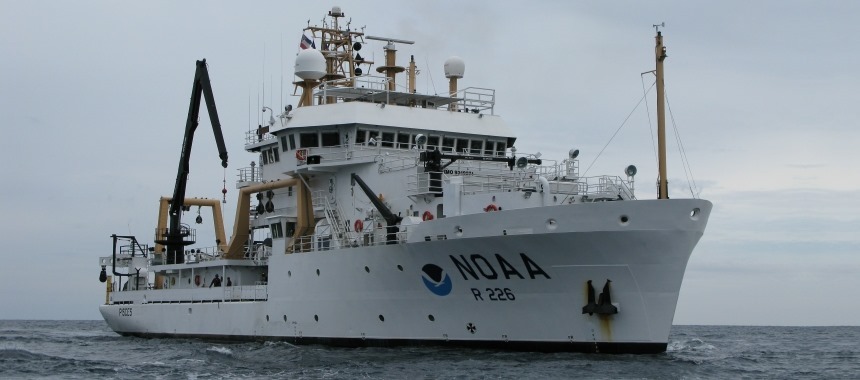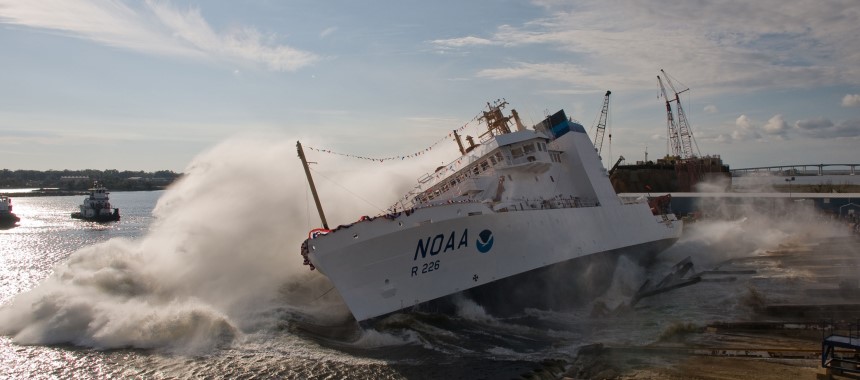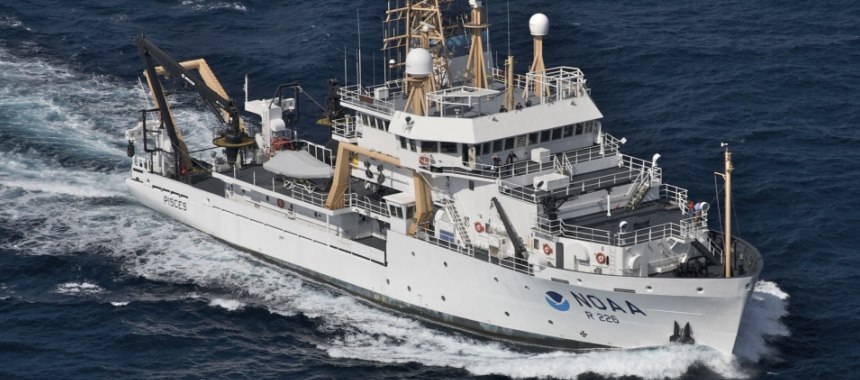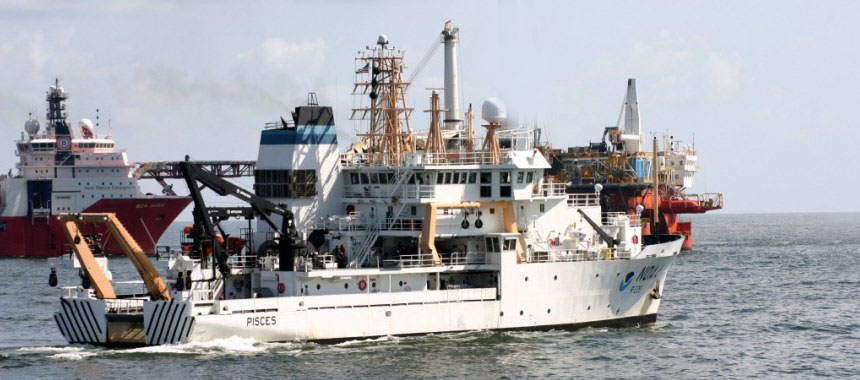The survey vessel Pisces

National Oceanic and Atmospheric Administration (NOAA) ship Pisces is the third of four new fisheries survey ships to be built by NOAA, representing a significant achievement in NOAA efforts to modernize its fleet of fisheries, oceanographic and hydrographic survey ships.
This 40-day endurance ship has been designed and built to modern commercial construction and safety standards by VT Halter Marine, Inc. under contract to NOAA. The ship Pisces and her sister ships comply with all U.S. Coast Guard and American Bureau of Shipping criteria. Pisces will carry a crew of 21 and up to 17 scientists on any given mission. The ship was named Pisces.
NOAA ship Pisces will support NOAA, mission to protect, restore, and manage the use of living marine, coastal, and ocean resources through ecosystem-based management. Her primary objective will be to study, monitor, and collect data on a wide range of sea life and ocean conditions, primarily in U.S. waters from the Gulf of Mexico, Caribbean, and South Atlantic to North Carolina. The data collected by the ship will be used by scientists who study variation in ocean conditions and sea life to better inform the nation, decision makers about such issues as sustainable fisheries, ecosystem structure and function, fish habitats and habitat restoration, coral reefs, and protected species status. The ship Pisces will also observe weather, sea state, and other environmental conditions, conduct habitat assessments, and survey marine mammal and marine bird populations.
The ship Pisces is a state-of-the-art research ship with multiple science mission capabilities. Foremost among these capabilities is the ship, a design feature that minimizes sound made by the ship underwater. This allows scientists to use hydro acoustic methods for surveying marine life, and significantly reduces changes in the natural behavior of animals caused by ship noise. In addition, the vessel can collect a variety of oceanographic data while marine life surveys are underway, resulting in both richer and more efficiently collected data. The shape of the trawl net is monitored during fishing operations. The ship is equipped with multiple sonar systems to meet its missions.

The ship Pisces carries equipment and systems to conduct fisheries, oceanographic, and hydrographic research in most areas of the U.S. Exclusive Economic Zone. The ship can support ongoing fisheries and oceanographic research by deploying and recovering floating and bottom-moored sensors. Surface buoys up to eight feet in diameter can be handled through hinged doors on each side of the working deck.
Water temperature, conductivity, and fluorescence can be measured as a function of depth using the hydrographic winches and a CTD system. Local water currents are measured with an Acoustic Doppler Current Profiler, while a state-of-the-art multibeam sonar system provides information on the content of the water column and on the type and topography of the seafloor while underway.
A traction-type oceanographic winch can deploy up to 5,000 meters (16,400 ft) of wire up to 17 mm (0.681 Underwater Operations) in diameter. It is located below the main deck and configured to support operations with the large, hydraulically operated stern gantry. The oceanographic winch can accommodate wire rope, electromechanical cable, and fiber optic cable as needed. Up to 13 metric tons of line pull can be generated by the oceanographic winch.

Two hydrographic winches serve the Side Sampling Station via the side A-Frame. Each hydrographic winch can deploy 3,500 meters (11,480 ft) of 9.5 mm (0.375 in) electromechanical wire. The A-Frame is configured so that up to three scientific packages can be rigged and ready for sequential operations. One hydrographic winch can also be rigged to deploy science packages off the stern.
Underwater radiated noise has been shown to influence fish behavior, and sonar self-noise can limit the effectiveness of hydro acoustic surveys and other functions. The International Council for Exploration of the Seas (ICES) has established a standard for ships, underwater radiated noise in order to effectively employ hydro acoustic stock assessment techniques. Pisces has been designed and constructed to meet this ICES noise standard. This reduced noise signature will improve NOAA, ability to accurately assess fish stocks and to compare standardized data with the international fisheries scientific community. Pumps, motors, ventilation, and piping systems are all designed for low noise, with some critical systems resiliently mounted in the ship. Hull structure is treated in critical areas with special acoustic damping tiles. Airborne noise has been reduced through-out the ship for personnel safety and comfort.

the ship is equipped with multiple sonar systems to meet its missions the shape of the trawl net is monitored during fishing operations
The ship Pisces has received extensive attention to both minimize the sources of noise and to ensure that systems are treated to reduce transmission of noise into the water. Examples are the propulsion motors, which are specially constructed and balanced to reduce noise and vibration, and the diesel generators, which are mounted on double- isolated raft Noise Control systems. The hull form and highly skewed, five-bladed propeller were carefully designed and tested using U.S.
On the board the ship most of the main deck is reserved for mission functions. The aft working deck provides 145 sq m (1,560 sq ft) of open space for fishing and other over-the-side operations, with an additional 33 sq m (355 sq ft) of deck space at the Side Sampling Station. Space and support connections are provided for a laboratory van on the aft working deck. Large, easily reconfigurable laboratories are designed to accommodate the varied needs of individual scientific cruises:
- fish/Wet Laboratory 56 sq m (602 sq ft)
- chemistry Laboratory 27 sq m (290 sq ft)
- dry Laboratory 15 sq m (161 sq ft)
- scientific Freezer 19 sq m (204 sq ft)
- controlled Environment Room 9 sq m (96 sq ft)
- preservation Alcove 5 sq m (54 sq ft)
- acoustic/Computer Laboratory 46 sq m (495 sq ft)
On the board the ship working deck and laboratory areas are equipped with flush deck sockets to mount transient equipment. Each laboratory is also fitted with a Unistrut mounting system for easy reconfiguration in response to changing mission needs. Additional mission areas include a large, walk-in scientific freezer, a conference room, a dive locker, and a dressing room for scientists and crew preparing room is provided in addition to the transducer mounting area on the bottom of the centerboard.
The ship Pisces technical characteristics:
- Full Load Displacement — 2,479 tons
- Light Ship Displacement — 1,840 tons
- Length — 63.6 m
- Beam — 15.0 m
- Draft — 5.90 m
- Maximum speed — 14.0 knots
- Accommodations — 38 persons, including 17 scientists
- Endurance — 40 days.
- Comments
 en
en ru
ru uk
uk